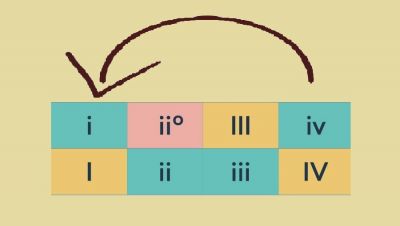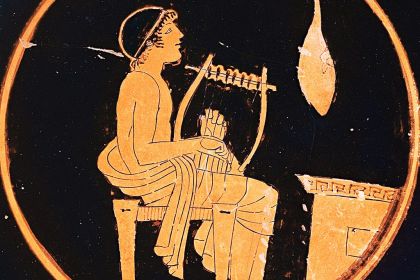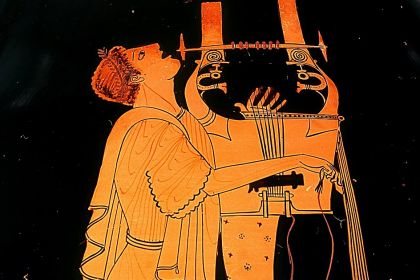Music Theory
Plagal cadence exemplified by 9 songs in all diatonic modes

Roman numerals indicating chords of minor and major scales
Genre: Rock
Musical Modes: Ionian Mode, Dorian Mode, Phrygian Mode, Lydian Mode, Mixolydian Mode, Aeolian Mode, Harmonic Major Scale
In musical theory, the term cadence is applied to the chord progressions that create a sense of resolution at the end of a musical phrase or period. The overwhelming majority of classical pieces and their sections are closed with a perfect authentic cadence, though there is another, albeit less common way to complete a phrase or musical form and it's by applying a plagal cadence.
A plagal cadence implies a harmonic turnaround in which the main subdominant chord rooted in the fourth scale degree is followed by the tonic chord of the first scale degree. This chord sequence is also known as the Amen cadence due to its frequent appearance alongside the word "Amen" in religious hymns.
In the major mode based on the Ionian major scale, the plagal cadence is formed by major triads rooted in the first and fourth degrees and is denoted as IV–I. Here both numerals are capitalized according to the rules of harmonic analysis in which major chords are marked with uppercase Roman numerals and minor chords with lowercase Roman numerals.
A plagal cadence specifies the application of the chords in the root position that creates the movement from the fourth to the first scale degree within the bass line, giving the listener a more rounded impression of completeness. When the bass line is constructed in such a unique fashion, the plagal cadence becomes open for the usage of subdominant chords other than IV though they should still derive from the same function.
In classical music, it is not uncommon for the first-inversion supertonic chord to be resolved into a tonic chord ii65–I within a plagal cadence. Rarer still are the instances of the tonic chord following the leading-tone seventh chord in its second inversion vii43–I. Both cases showcase the bass line movement by the descending perfect fourth or the upward perfect fifth. Although the leading-tone chords represent the dominant function, their second inversion structurally resembles the main fourth-degree subdominant chord, which explains their appearance in plagal cadences.
Another type of plagal turnaround occurs in the endings of musical forms when, following a perfect authentic cadence, any of the three subdominant-function chords may appear within a tonic chord: I–IV64–I, I–vi6–I, and I–ii2–I. Such post-cadential sequences are usually performed to the backdrop of a tonic pedal point and are intended to pacify the musical narrative after a particularly strong cadence or to connect two sections of a piece.
A rather compelling example of a plagal cadence that appears alongside a post-cadential turnaround is shown in Let It Be by The Beatles which is written in Ionian major mode. The song, composed in the key of C major, uses the following chord chains in the verses:
- C–G–Am–Fmaj7 or I–V–vi–IV7
- C–G–F–C–Dm7–C or I–V–IV–I–ii7–I
Here the plagal cadence first appears at the close of the first line where the Fmaj7 subdominant seventh chord precedes the tonic chord at the beginning of the second line. Another plagal cadence F–C appears in the second line and is followed by the post-cadential plagal sequence I–ii7–I with the Dm7 supertonic seventh chord.
The same plagal cadences are found in both chorus sequences:
- Am–C–F–C or vi–I–IV–I
- C–G–F–C–Dm7–C or I–V–IV–I–ii7–I
Curiously, the initial four chords of the second line I–V–IV–I reveal the following sequence of diatonic functions: tonic–dominant–subdominant–tonic or T–D–S–T. The theory explains that such cadential sequences are not entirely natural since the main subdominant-function chord appears immediately after the main dominant-function chord and not vice versa.
Listen to Let It Be by The Beatles:
In the Aeolian minor mode—based on the natural minor scale—both chords involved in the plagal cadence are minor chords: iv–i. A clear example of a minor plagal cadence can be found in Red Hot Chili Peppers' Dani California which is written entirely in the key of A minor:
- Am–G–Dm–Am or i–VII–iv–i for verses
- F–C–Dm–G or VI–III–iv–VII for choruses
Here, the Dm–Am plagal cadence appears in verses to close each pair of rhymed lines.
Listen to Dani California by Red Hot Chili Peppers:
A combination of major and minor plagal cadences is typically utilized in cases where a heightened form of expressiveness is required in the piece. Mostly performed in Ionian mode, such progressions begin with a major subdominant chord that switches to a minor subdominant chord on its way to the tonic chord IV–iv–I. In this sequence, the sixth scale degree is lowered by a semitone, thereby converting the Ionian diatonic scale to the harmonic major scale.
A typical example of a major-minor plagal cadence is found in The Beatles' In My Life with the verses arranged in the A major chord sequence: A–E–F♯m–A7–D–Dm–A or I–V–vi–I7–IV–iv–I. It should be noted that the tonic seventh chord A7 is replaced by the D subdominant chord, fully corresponding to the classical canons in which a seventh chord resolves itself into a chord built on a note that should be a perfect fifth below the root of the seventh chord.
Listen to In My Life by The Beatles:
In both classical and popular music, it is common to find pieces written in the major mode in which a minor subdominant chord precedes a major tonic chord iv–I. Additionally, the major subdominant chord does not appear immediately before the minor subdominant chord, although it may occur elsewhere in the sequence.
An example of this type of cadence can be heard in Ain't It The Life by Foo Fighters composed in the key of C major with the verses built on the following looped chord chain: C–Am–Fm–C–Em–F or I–vi–iv–I–iii–IV. In the middle of the progression, the Fm minor subdominant chord is replaced by the C tonic chord, while the F major subdominant chord closes the progression which forms the plagal cadence together with the tonic chord at the beginning of the next chord chain.
Listen to Ain't It The Life by Foo Fighters:
Another example of a minor plagal cadence performed in the Ionian mode is observed in Radiohead's No Surprises written in the slightly lowered F major. The song's intro is based on a looped two-chord riff and shows the classic plagal cadence of F–B♭m or I–iv. The chord chain that sets the base for the development of the verses can be denoted as follows: F–Dm–Gm–C–F–B♭m–F or I–vi–ii–V–I–iv–I. This progression uses a perfect authentic cadence with the Gm supertonic chord, the C dominant chord, and the F tonic triad followed by a post-cadential plagal sequence B♭m–F.
Listen to No Surprises by Radiohead:
In the Mixolydian major mode, both chords forming a plagal cadence are major chords which imply Mixolydian plagal cadences to be no different from those in the Ionian major: IV–I. One of the typical Mixolydian plagal cadences appears in Seven Bridges Road written by Steve Young and arranged by Iain Matthews. The song reveals a D Mixolydian chord progression that bleeds into a major plagal cadence at the end: D-C-G-D or I–VII–IV–I.
Listen to Seven Bridges Road performed by Eagles:
Listen to Seven Bridges Road performed by Eagles:
A plagal cadence in the Dorian minor mode is usually shaped by a major subdominant chord that resolves into a tonic minor chord: IV–i. An example of such a chord sequence is seen in the traditional English ballad Scarborough Fair which owes its current popularity to the American folk-rock duo Simon & Garfunkel whose version of the song is arranged using A Dorian. Here are the chord progressions for each line of the song's verses:
- Am–G–Am or i–VII–i
- C–Am–C–D–Am or III–i–III–IV–i
- Am–C–G–Am–G or i–III–VII–i–VII
- Am–G–Am or i–VII–i
The example shows the Dorian plagal cadence that closes the second line of the verses to be D–Am.
Listen to Scarborough Fair by Simon & Garfunkel:
In the Phrygian minor mode, the main plagal cadence is performed identically to the natural minor mode given that both of these formative triads are minor chords: iv–i. Coz I Luv You by Slade showcases very simple harmonic sequences representing A Phrygian:
- Dm–Am or iv–i for verses
- B♭–Am or II–i for refrains
The song's verses are performed in the Dm–Am looped plagal cadence, while the choruses reveal a typically Phrygian plagal turnaround using the B♭ supertonic major chord known as the Neapolitan chord.
Listen to Coz I Luv You by Slade:
In the Lydian major mode, the subdominant triad rooted in the fourth scale degree is a diminished chord which explains its extremely rare use in pop music that generally avoids diminished chords. At the same time, the progressions that combine the major supertonic chord and major tonic chord are brought to the foreground as the main plagal turnover of the Lydian mode: II–I. Many songs are based on this simple alternation considered to be the highlight of the Lydian major. For example, Fleetwood Mac's Dreams features just two chords in F Lydian: F–G or I–II.
Listen to Dreams by Fleetwood Mac:
Of all seven diatonic scales, only the Locrian scale contains the interval of a diminished fifth which divides the first and fifth scale degrees. This means that the tonic triad of the Locrian mode is a strongly dissonant diminished chord that cannot provide a stable tonic function, making the Locrian mode mostly theoretical.




Country Roads by John Denver also ends in a Plagal Cadence. Key of A. Last two chords are D - A.
Indeed, the verses and choruses are written wholly in the key of A major, and the plagal cadence D–A closes every pair of lines:
A–F♯m–E–D–A or I–vi–V–IV–I for verses
A–E–F♯m–D–A–E–D–A or I–V–vi–IV–I–V–IV–I for choruses
Listen to Take Me Home, Country Roads by John Denver: